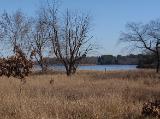Birds Bring New Recognition for Leopold Memorial Reserve by Craig Maier
“The physics of beauty is one department of natural science still in the Dark Ages. Everybody knows that the autumn landscape in the northwoods is the land, plus a red maple, plus a ruffed grouse. In terms of conventional physics, the grouse represents only a millionth of either the mass or the energy of an acre. Yet subtract the grouse and the whole thing is dead. An enormous amount of some kind of motive power has been lost.”
– Aldo Leopold, A Sand County Almanac
It’s no secret that bird populations are declining in Wisconsin, across the Americas, and around the world. The Important Bird Area Program (IBA) is playing an important role in responding to this global phenomenon by identifying sites where some of the “motive power” of a landscape—the place’s characteristic birds—can be protected or brought back.
In October 2007, the Aldo Leopold Foundation, IBA partners, and Wisconsin DNR Secretary Matthew Frank came together to celebrate the dedication of the Leopold-Pine Island IBA. Encompassing 11,000 acres, this IBA includes the Leopold Shack and Farm owned by the Aldo Leopold Foundation, public land owned and managed by federal and state conservation agencies, and individual landowners. In addition to the unique mix of landowners, the IBA spans miles of Wisconsin River floodplain and adjacent uplands, with ecosystems from dry, sandy black oak “barrens” to lush floodplain forests.
The dedication was hosted by Phill and Joan Pines, private landowners in the IBA, and stewards of 2,300 acres just across the Wisconsin River from the Shack. The calls of sandhill cranes passing overhead added both historical perspective and a sense of hope to a gathering motivated by bird conservation.
In the 1930s and 40s, Leopold was concerned about the dwindling population of the sandhill crane, when only a handful of mating pairs survived in Wisconsin’s sand counties. Journal records from visits to the Shack during that era note only one sighting, when Leopold flushed a pair from the marsh south of the Shack. Today, the sandhills breeding in Wisconsin have recovered, and thousands of sandhill cranes—an estimated 10 percent of Wisconsin’s population—roost during fall migration on Wisconsin River sandbars and shallows protected by the Pines.
The Pines purchased the first 400 acres in the late seventies, eventually purchasing a total of 2,300 acres and protecting a large area of shoreline and floodplain forests from development. Phill Pines has been particularly devoted to restoring wetlands and prairie that had been drained and plowed for farming. With guidance from ALF and the Wisconsin Waterfowl Association, a dried-up stream channel, approximately 100 acres of wetland, and 60 acres of prairie are being restored.
The Pines’ dedication to the land exemplifies the sense of personal responsibility that Leopold described as a land ethic. “With the majority of land in Wisconsin being privately owned, conservation on private lands is an absolutely critical piece of the puzzle. Phill and Joan and other private landowners within this IBA truly are leading by example,” said Yoyi Steele, Wisconsin’s IBA Coordinator.
“Birds don’t care if they’re on public or private land, a wildlife area or a park or a county forest or someone’s back forty,” Steele explained. “They care about habitats and the resources they need. Conservation will not be as effective if you don’t pay attention to the way birds use landscapes, and try to meet their needs across those landscapes,” Steele said.
The original IBA proposal focused on the historically significant Leopold Shack and Farm and the diverse and extensive Pine Island property, but the potential for wider collaboration was soon apparent. The proposal expanded to include the Pines’ property, the entire Leopold Memorial Reserve, the Lower Baraboo River Waterfowl Production Area (a collaboration between the Natural Resources Conservation Service and the US Fish and Wildlife Service), and the Lower Baraboo River Floodplain Forest, including USFWS and private property.
Each IBA must meet several scientific criteria to be approved, so collecting data was an initial focus. In 2005, baseline surveys were conducted to determine which bird species were already using the properties for breeding habitat or during migration. Wisconsin DNR ecologist Mike Mossman conducted surveys during the breeding season, crossing and re-crossing the Leopold Memorial Preserve, Pine Island State Wildlife Area, and the Pines’ property on foot and by canoe.
A corps of volunteers coordinated by the Aldo Leopold Foundation also visited the properties during spring migration, the summer breeding season, and fall migration. Eight experienced birders volunteered over 200 hours of their time and recorded 1,600 observations. The Leopold-Pine Island IBA’s surveying protocol has been identified as a possible model for future proposed IBAs.
The data showed that many species of high conservation concern were using the properties during the breeding season, including blue-winged teal, yellow-billed cuckoo, bald eagle, osprey, woodcock, blue-winged warbler, red-headed woodpecker, willow flycatcher, vesper sparrow, Henslow’s sparrow, and bobolink. The surveys documented 108 species breeding on the IBA in floodplain forest, marsh, open water, oak savanna, and several types of grassland.
Partners met in May of 2007 to discuss the findings of the bird surveys, tour the properties, and discuss possible paths for the future. The discussion is ongoing, but one early result was ALF and the DNR collaborating on a grant proposal to fund invasive species control and other management in swamp white oak savannas, a rare native plant community found on both the Leopold Farm and Pine Island.
“I don’t see this as static,” said Kevin McAleese, program director for the Sand County Foundation’s work on the Leopold Memorial Reserve. He hopes the IBA will serve as a means to connect to more private landowners in the area—“The IBA designation is just a beginning, an indication of what’s possible.”
Additional Resources
Audubon Important Bird Area Profile: Leopold-Pine Island IBA






